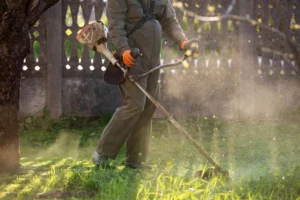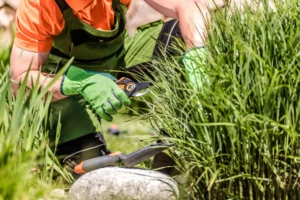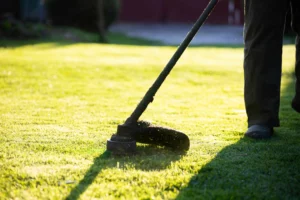Do you need to carry out a lawn dethatch? Read on to know why, when, and how to dethatch your lawn.
Your lawn doesn’t seem to grow as it should. It may be because of a thick layer of thatch that keeps water and nutrients from reaching the roots of your grass. The lawn is the most demanding part of your place. It requires constant maintenance throughout the year.
Not all lawns need dethatching, but when your yard does need it, knowing how to dethatch is crucial for its growth. Correctly done, a lawn dethatch helps restore the health of your yard and keep it looking beautiful. You can keep your thick, lush grass on track by learning when to dethatch your lawn.
What Is Thatch?

Thatch is a matted coating of grass stems, roots, rhizomes, stolons, and other organic debris that forms up faster than it can decompose. Thatch accumulates instantly below the surface of the grass and on top of the soil.
A layer of thatch less than ½ inch thick is standard and is not a matter of concern. A delicate layer of thatch is a good thing. It decreases soil compaction and increases the temperature tolerance (hot and cold) by guarding the crown (end of a plant where the growth of the grass originates). Thatch can also lower the water loss through evaporation.
If the thatch is more than ½ inch thick, it may cause a problem. Consider it as a layer of plastic wrap on top of the soil. Your grass will not have access to water, air, and nutrients because thatch clogs them from reaching the roots.
A thick layer of thatch can carry disease-causing fungi and insects, extend high humidity that promotes disease, and tie up pesticides.
Why Is a Lawn Dethatch Important?

As you already know, thatch can cause many problems for your lawn, and if you are serious about getting your yard to flourish, you will need to consider tackling your thatch problem. Consider the following benefits of dethatching your lawn:
-
Enables Fertilizers to Reach Soil
Thatch tends to form a thick layer around the grass base. It prevents fertilizer from reaching the soil. Lawn dethatch will help you find that the health of your plants improves significantly because the fertilizer can do its job without restriction.
-
Improved Soil Health
The nutrients in the soil tend to decline as it is difficult for anything to penetrate through a thick layer of thatch. Until you dethatch your lawn, your grass may still grow, but it will not be healthy. Dethatching will help your yard get essential water, sunlight, and air and improve soil health.
-
Sufficient Nutrients
Though people assume they can utilize thatch as compost for the plants, this is not true. While thatch may include dead plants, it restricts your grass and plants from accessing the essentials required to survive. Lawn dethatch will help your plants to gain the sufficient amount of nutrients that they need to grow.
-
Makes Your Lawn More Beautiful
A thatch-covered lawn will have very unhealthy growth. Dethatching is a great way to stop this issue and give your grass and plants a chance to flourish again.
-
Water Gets Through
No matter how considerably you water your plants, a thick layer of thatch, very little water reaches the soil and nourishes them. Lawn dethatch will allow the water to penetrate easily into the ground and feed your plants.
-
Prevents Disease
Thick layers of thatch can be an excellent spot for insects and various fungi to grow and survive. This will likely make your plants infected. Getting rid of the thatch will stop your plants from becoming exposed to disease-carrying agents.
When Should You Go For A Lawn Dethatch?

Before dethatching, check your lawn’s thatch layer. If your thatch is 1–2 inches or more, you know your thatch has exceeded the healthy mark. Therefore the time for lawn dethatch has come.
Cool-season grasses, such as Kentucky bluegrass, shall be dethatched in late summer or early fall. Whereas warm-season grasses, such as Bermuda grass or Zoysia grass, need a dethatch after spring. Never dethatch at times of the year when you are expecting weed seed germination. The process of dethatching will bring seeds to the surface.
How To Do A Lawn Dethatch?

A thatch over 2 inches thick requires a professional like Pro Green Lawn Services for the job. Excessive thatch takes more than one removal session. Extracting too much at once can damage the roots of your grass.
You can dethatch your lawn in three ways:
- Manual dethatching rakes are short-tined with curved blades designed to dig your lawn and pull up thatch. Dethatching rakes are appropriate for light thatch and general maintenance on small lawn areas.
- Power rakes are mower-like machines with rotating, rake-like tines that dig into the thatch and pull it up. Power rakes function well for lawns with thinner thatch layers and grass that can resist intense raking.
- Vertical mowers, also called verticutters, have vertical blades that cut down through the thatch layer and into the soil. It pulls thatch and often grassroots from the surface. Verticutters are most suitable for the thick layer of thatch needing renovation.
Mostly yards and garden stores carry manual dethatching rakes. At the same time, you can find power rakes and vertical mowers in equipment rental stores.
Whatever option you choose, complete the job by raking up all the thatch remains and watering your dethatched lawn thoroughly.
Need A Hand For Your Lawn Dethatch?
Getting your lawn to look flourishing and green is the dream of anyone who loves gardening. Dethatching is a distinctive part of getting your yard to that stage! Before undertaking your dethatching project, you should consult a professional to get a better view of your lawn.
Professionals at Pro Green Lawn Services will help you with your lawn dethatch. We use the chosen method to eliminate excess thatch from your yard that builds up over time.
Contact us now! To get a healthy environment for your turf to thrive.


